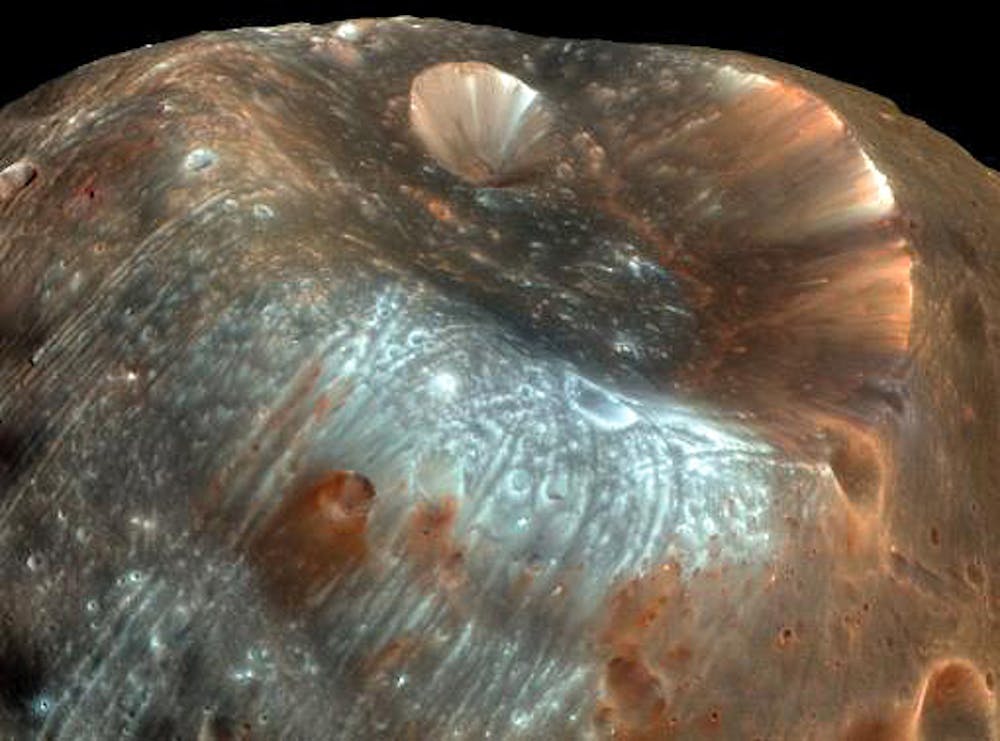A recent study by University geologists will help inform a Russian mission to the Martian moon, Phobos. The mission, which is planned to launch mid-2020, will be the first to return with deep-space material, including material from Mars and will potentially answer questions about Phobos’ origin.
The Russian space agency’s first attempt to collect samples from Phobos in 2011 was unsuccessful due to a spacecraft engine failure before it left Earth’s orbit, said James Head, professor of geological sciences and lead author of the study.
The study, published last month in the journal Planetary and Space Science, provided an estimate of the amount and location of Mars fragments that scientists could expect to find on Phobos so that mission planners can pick the right landing spot. The concentration of Mars fragments in the outer layer of Phobos’ crust is about 250 parts per million and can be found right at the surface, according to the study.
“Half of the material that came from Mars is probably within the first meter so you don’t have to dig a lot to find it,” said Ken Ramsley, co-author of the study and a visiting investigator in the School of Engineering. The Mars fragments are concentrated at the surface because Phobos’ orbit is gradually spiraling closer to Mars over millions of years, meaning older, deeper layers will have a lower concentration of Mars material than the newer layers at the surface, Ramsley said.
Phobos also has almost no gravity, so ejected pieces from Mars that collide with it will simply bounce back off and later re-intersect with Phobos on the opposite hemisphere with less force, Ramsley said. This accounts for why there is an even distribution of Mars fragments on the surface of Phobos, which means that a spacecraft can land almost anywhere to be able to collect a sample.
“That’s a big relief,” Ramsley said. “We have a really hard time getting within a few miles of where we want to get to in space.”
Though the concentration of Mars fragments — 250 parts per million — is not particularly dense, it is enough to be able to differentiate Mars fragments from the Phobos sample, Ramsley said. Mars and Phobos are in “the same shooting gallery,” which means they both get hit by about the same number of asteroids and projectiles, he added. Phobos gets hit directly from external projectiles about 200 times more than it gets hit indirectly from Mars ejecta. Based on a model of Earth’s own moon, Ramsley was able to calculate that about 3 percent of Phobos’ outer surface will contain projectiles from parts of the solar system beyond Mars. He then used these data to figure out the amount of Mars material on the surface of its moon.
Calculations from this study matched calculations from other studies that used different methods to estimate the concentration of Mars material on Phobos, Ramsley said. “That almost never happens.”
The study and the future mission is “going to really help us answer the question of where Phobos came from,” Head said. “It’s a big deal.”
Scientists are not sure whether Phobos is an asteroid that has been captured in Mars’ orbit or a piece of Mars itself that got blown off in an impact, Head said.
If Phobos was originally an asteroid from outside the Martian system, it is far more likely that it has water, Ramsley said. But if it formed as a result of “a giant impact very early in Mars’ history” then the probability of finding water on Phobos is very slim, because the heat from the impact would have dried out any water that may have been there.
“It really comes down to where it came from,” he said. “I happen to subscribe to the hypothesis that it originated from a giant impact.”
The mission has been a “long-term quest” that will be a “two-for-one” because it will return samples of both Phobos and Mars, Head said.
The project “has been the result of a long history of interaction” between the U.S. and Russian space agencies, he said. Head first became involved with the Soviet space program in the early 1970s with the help of former University President Howard Swearer and Director Emeritus of the Center for Foreign Policy Development Mark Garrison. “Our cooperation has grown out of those early days,” he said.
Head is currently working closely with his Russian colleagues to ensure the success of their second attempt to land on Phobos. The engine failure during the first attempt was a major setback. “There’s a queue. (The mission) got bumped out and had to go to the back of the line,” Head said. But he added that he is confident that the mission will take place in mid-2020.

ADVERTISEMENT




